Q&A du C-U: Eleanore Stasheff
“Muffins and Penguins and Lizards, Oh My!”
An interview with Eleanore Stasheff of EIDOLON and Sine Fine Films
by Jason Pankoke
I don’t watch television. Period. Well, except for peeking glances at the fare flickering on-and-off in the bars like schizophrenic, subtitled ghosts from beyond. And exercising my late-night right to speed-dial through the proverbial 57 channels with nothing on when I visit relatives. I did recently sit through my first complete football game in several years, actually, the one where the Cowboys stumped the Colts … Maybe I’m just fooling myself. Let’s revise the claim. We all watch the Boob Tube to some degree, whether deliberately or not.
However, I’ve been weaned off the daily need for such electronic boobery since college, when I closed out my formal education during the same weeks that CHEERS and NIGHT COURT finished their runs and student cliques gathered ‘round for weekly first-run helpings of THE X-FILES, STAR TREK: THE NEXT GENERATION, and quality-era SIMPSONS. Pretty much anything that lights up my set these days comes straight from a cassette or a shiny silver disc, given the not-ready-for-prime-time mayhem that trickles in for advance review via MICRO-FILM, and I have yet to transform my computer into an unofficial teevee. I know that every day, every hour, I probably miss out on something worthwhile, and I don’t really mind at all.
In the case of Eleanore Stasheff’s work, I mind. Cable access and community college airwaves are the provinces for her shows, appearing with meager fanfare in half-hour fits of eager-to-please fantasy that make the neon-lit professional serials seem rote in comparison. I found out about this Urbana tale-spinner and her multi-part opus PANDORA’ S BOX (2001) while slaving for The Octopus a few years ago and, given my keen awareness that interesting things often start incognito – witness the basement “talk show” from upstate Aurora that inspired “Wayne’s World” on SNL – you would think I’d know better than to ignore the local listings. Eleanore’s heroines always seem one step ahead of me regardless, traversing space and time to rescue a handsome squire or crazy artifact with amusing quips at the ready, fading to black before I can materialize on the other side of the screen.
Maybe I’m being too hard on myself. Let’s reverse the curse, shall we?
Read on, MahDeer…
Jason Pankoke: Thanks a bunch for chatting with us for the third-ever original interview on C-U Blogfidential! Let’s talk first about the current status of Erion Entertainment, which has recently been rechristened Sine Fine Films for its 10th anniversary. What inspired the name change?
Eleanore Stasheff: Well, the company was originally called Starlight Productions, but then I found out that name was taken by about a billion other companies – or maybe 26 – so I changed the name to Erion Entertainment after a character in the first three movies, played by Jen Weber. The only problem is that the way I wanted the logo to look always made [Erion] seem like Tinkerbell, since she was a fairy who happened to wear sea-foam green.
I tried a bunch of different names but none of them seemed to work or feel right. So in the end, at the suggestion of Diana Neatrour, I created the logo first and then [settled on] Sine Fine Films which, in Latin, translates to “Without End” Films … and television shows are films without end. Also, I am notorious for never-ending filming days and projects, so you could also think of it as “filming without end.” Any of the actors who’ve been in my projects will tell you that it’s pretty much true.
JP: “Film Without End” actually sounds like a great concept for a future Sine Fine series! It would also be a good title for an Irwin Allen-style disaster epic, which have seemingly become in vogue on network television – a depressing development, really, given the real-life natural disasters that have occurred in recent years.
ES: I don’t think the rash of natural-disaster movies and television specials is unusual. Story telling themes go in cycles in the entertainment industry because they reflect the themes cycling through the audience [and their] human consciousness. Sometimes there is a rash of ghost movies, because the spiritualist and supernatural theme [in regards to the afterlife] is being desired and expressed. Or, there may be a rash of war movies, often dealing with a specific war, because the universal war theme is pervasive in the culture.
JP: In contrast, Sine Fine Films productions take their overt cues from another arena of storytelling that is usually more light-hearted – the fantasy-mystery filled with high adventure, clear-cut good and bad guys, stylish period garb, and magic spells aplenty. What is your inspiration for creating serials that emphasize thrills and escapism over, say, the “realism” that marks much of today’s television dramas?
ES: Unlike most filmmakers, my college degree is not in film. It’s a BA in University Studies – I’m qualified to study a university and say, “Yup! It’s a university!” – with an emphasis in Cinema and Anthropology and a minor in Classical Civilizations. (I can also say “Luke, I am your father” in Latin!) I have no high aspirations of creating great works of art or gritty hard-core dramas that will crush your spirit and win me an Emmy. I just want to tell a story. If you think about it, that’s all most filmmakers and television producers are – storytellers. If we lose sight of telling a good story, then what’s the point? I hate sitting through a two-hour movie that tells a story badly or doesn’t tell one at all.
So, why do I choose to tell stories the way I do? Several reasons: I love fantasy. I love magic and the supernatural. I love mythology. (I eat universal archetypes for breakfast … and lunch … and dinner, because they taste so yummy!) I love costumes. I grew up in the theater. (The first play I was ever in was Shakespeare’s A Midsummer Night’s Dream.) My father is a science-fiction/fantasy author.
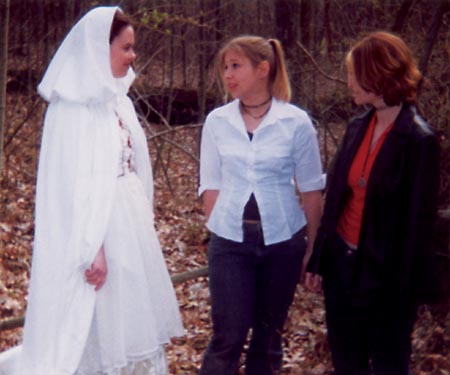
As for escapism, I ask you – what’s wrong with that? So many fancy critics and artsy filmmakers look down on escapism. They don’t want to use film to show people an illusion; they want reality. I don’t. Call me crazy, but I don’t want to pay 10 bucks to be depressed. I get enough of that for free.
I want to step outside my own world for an hour or two and live someone else’s life and have adventures and romance and live happily ever after even if it’s just for one night. I want that movie ticket to be a plane ticket to fly me off into another reality. I want to suspend my disbelief that the pyramids were not built by aliens, that there wasn’t anything in that windmill to make it blow up, and that the princess’ boobs were so not her own.
So, naturally, if that’s what I want to see, then that’s what I want to make.
JP: Yet, behind formulating the engaging story and embodying it in a satisfying dollop of escapism, there’s the real-life ethics of hard work and dedication that must go into the behind-the-scenes for the filmed story to take shape as intended. Most people are sure to take notice that you have produced several movies and numerous episodes since you began.
ES: I will admit to being unusually prolific for an amateur with a budget that strongly resembles the cost of a large pizza. I’ve produced, directed, edited, and costumed 10 movies and six television shows, and written all but two of the movies, resulting in more than 60 hours of edited programming – all in the last 10 years.
I have to say that I owe a huge thanks and a large amount of the success of my projects to the very hard-working, dedicated, and talented actors who also and often served as crew – many of whom did not know what they were getting into until it was too late. (I lock the doors at ten.) (No, that’s not true.) They’ve put up with a lot of very long, grueling days [involving] late hours, blistering hot, freezing cold, pouring rain, ravenous mosquitoes, and practically anything else you can imagine. Some of them have even been with me for all 10 years, which makes me wonder if they’re gluttons for punishment or just as crazy as I am…
JP: It’s extremely cool – and gratifying to you, I’m sure – that you have a mutual loyalty with the folks that you work with. Which Sine Fine players have been the consistent “regulars” over the years, and what qualities make the typical Sine Fine crew click, regardless of the scope of one’s contributions?
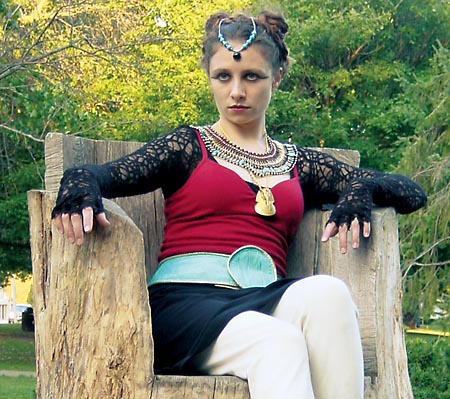
ES: The quintessential regular is by far Annamarie MacLeod. She’s been in more movies and TV shows than anyone else – 14 out of 16, in fact – and is one of the most talented and amazing actors I know. Jen Weber is another awesome actor who’s been in tons of projects – 12 out of 16. Another person I have to mention is Diana Neatrour who has not only acted in several, but is the script editor and my personal muse.
Also, every member of the MacLeod family has participated more than once, and their farm has been used as a shooting location almost as many times as Annamarie has appeared in a project. Mark, Michelle, Jacob, Chris, and Annamarie all are amazing performers and people; I couldn’t have done half of what I have without them. Every member of my own family has “volunteered” to participate, of course, but my brother Edward has been in [the most] – nine out of 16 – and he actually seems to enjoy it. Bonus!
Other people I’ll list according to who is most likely to be reading this article. I’d like to give a shout-out to the stunningly gorgeous and fabulously talented Margaret Olson, Rachel Anderson, Kate Weber, Nina Samii, Christopher Hutchens, Morgan Thomas, Brittany Ann Whalen, James McKinley, Bryan Kieft, Syndi Eller, Russell Martin, Ryan Homberg, Michael Bunnel, Christine Komiskey-Kastorff, and Aaron Thomas.
What was the second part of the question? Oh, right, what qualities make the SFF crew click.
A sense of humor, I think, is the biggest thing. There are a lot of situations where we should be (and probably are) miserable, but still find ourselves laughing. There’s also a big sense of community on the set. For many of the actors, this is the only time they get to see each other because we’re not all from the same place, physically or otherwise. When you go through some of the things that happen on the set – such as [weathering] a 16-hour day covered in ripped clothing and fake blood, freezing in a dark, dank cellar or the middle of the woods – you tend to form a close bond. Moments like that can make you friends forever. God, I’m such a nice director!
JP: It’s probably a good thing that these folks are indeed friends, because given the demands of making movies or serials on a scrappy budget, it definitely takes something a bit extra to also remain friends of The Cause.
Maybe to get a perspective on what your works (and working conditions) are like, we should discuss your most recent long-form adventure, EIDOLON. If I remember correctly, the last time we talked in-depth, you were in the middle of hightailing it all over the great state of Illinois to shoot the project. I believe that you were intending this production to be the capper of “Stage 1” of what was called Erion Entertainment…
ES: I’m famous for saying, “I swear, this movie is going to be the last one I do – I’m not filming any more!” And I always make another one, so even though I intended not to make something after EIDOLON, I – of course – did. I have decided not to say that any more because I want to make something at least once a year, some small movie or something just for fun. I’m addicted to filming and editing.
EIDOLON thus far is the last of the large-scale TV shows because it’s expensive to film that much with that many people. Like a lot of my TV shows, however, it didn’t start out that big. It was supposed to be only eight half-hour episodes and ended up being 13 episodes. And, it was only supposed to be filmed over the course of three months during the summer, but in the end took almost a year to film.
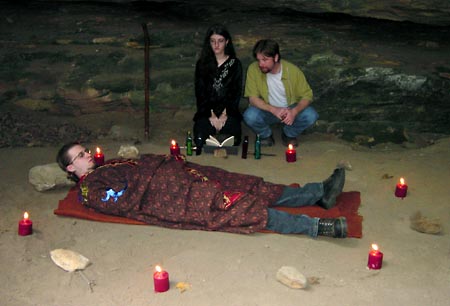
It’s probably the biggest project I’ve undertaken to date because it involved actors and locations from all around the state. We filmed by Lake Michigan and by Goreville in southern Illinois as well as here in Champaign-Urbana, and many places in between. Of the six principal actors, two were from the Chicago area, two were from Champaign, one was from Pekin, and the other was from the Springfield area or Carbondale, depending on the time of year. Getting everyone together was challenging enough; add in the longer-than-planned shooting schedule, and weather also had to be factored in.
So, in many ways, it was a nightmare production-wise, but overall everyone had a blast and it’s a lot of fun. And, it looked great – that’s the important thing, right?
JP: Absolutely! One wonders if you might have set a record for the most locations ever used in Illinois for a single production. Or, at the least, the most miles logged.
ES: We filmed in more than 25 locations, so yeah, that’s a lot I guess. For a TV show, though, it doesn’t seem like it’s too many, but they were all over the place and that did make it challenging.
JP: I was hoping that we could recount what happens in EIDOLON, for those who have not seen the series, because I’m guessing that its mix of elements is pretty representative of your work to date – an obvious assumption, given that EIDOLON is a sequel to another one that also has a prequel.
ES: EIDOLON is about a teenager named Zelda who hates ghosts and hunts them down, trapping them in magic lockets. One day, she hunts the wrong ghost and ends up getting cursed to be a ghost. So, she becomes what she hates most and has to turn to the only person who cares about her for help, her legal guardian Maria. Beyond that, it starts to get confusing.
However, EIDOLON is more representative of my later work at SIU-Carbondale, but not my early stuff. The movie that really is a perfect summation of the “Yibbleverse,” as I like to call it, is the most recent movie, THE CURSED DESTINY OF PANDORA’S GIFT BOX, which takes the most common characters, plot devices, etc., in all of my movies and makes fun of them in a good way.
It’s about three sisters – a bitch, a nut, and a ditz – who all get cursed, then get a magic box which allows them to travel through time. They meet a prince whose throne was usurped by his evil uncle and an evil, power-mad villainess with a sidekick that is the suave and debonair “cursed ghost of a pirate sorcerer.” He promptly falls in love with the bitch, the prince and the ditz fall in love, and the nut carries on conversations about muffins and penguins with giant purple lizards. There are a lot of jokes, music montages, and costumes. It’s rather fabulous if I do say so myself, mostly because it plays off of cliché [found in] general adventure/fantasy movies, not just mine.
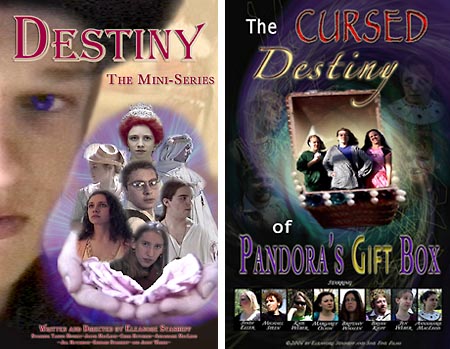
JP: Curiously, I just had framed a Ray Harryhausen exhibit poster, so you know what jumps out at me from your description, right? “Giant purple lizards.” [Laughs] I’d have to presume that we’re talking less Harryhausen animated majesty and more “Rats of Unusual Size” from THE PRINCESS BRIDE, but I digress heinously…
This is actually the first I’ve heard of CURSED DESTINY. Is this another series or a singular show, and would you consider it the legitimate “finale” to all your prior productions as Erion? I’m guessing that, maybe, this particular show was made less for public consumption and more for you and the Sine Fine faithful…
ES: The “giant purple lizard” is a very bizarre in-joke, actually. So is most of CURSED DESTINY, and yes, it was made mostly with members in mind. However, people who have never stepped on set and have never seen a single Sine Fine production have found it very funny as well. It features mostly Sine Fine regulars including Annamarie MacLeod, Margaret Olson, Kate Weber, Brittany Ann Whalen, Bryan Kieft, Syndi Eller, Jen Weber, and newcomer Michael Steen.
It’s a very entertaining 32 minutes [and it] would make a fine “finale” to the Sine Fine Films productions, but I had too much fun making it (in one weekend), so I’ve decided to do something once a year – nothing as big as EIDOLON until I have actual crew and a large budget not provided by me. I won’t stop making movies until I die, I suspect. In fact, there may be one or two posthumous ones if someone else decides to edit them for me. But, that’s hopefully a long, long way off. Right. Anyway. Next question, please.
JP: Okay, next question – how does one get to watch your shows? Your main outlets since you began have been local PBS and cable access…
ES: Unfortunately, I can’t sell copies of my movies or shows because the music is not original and although the TV stations that have aired it have ASCAP and/or BMI licenses, I don’t and can’t profit from using other artists’ work – nor would I want to. I really need to become good friends with a composer. And an orchestra. Or, a band. That would help a lot. I can write, direct, produce, edit, costume, run camera, even do a little lighting and basic audio, but I can’t write music.
So, where can you view my past shows? Hopefully soon, on Urbana Public Television. All future projects will hopefully have original music and be shown on YouTube.com. Look for that sometime in the spring.
JP: Considering this area’s rich talent base in music, I’d think you would have no problem finding willing groups to score or provide tunes for your films. (Besides, could you imagine “An Eleanore Stasheff Movie” with music by Elsinore or The Eleanors? The alliteration boggles the mind!) Do you prefer “classic”/symphonic music a la John Williams, or a more pop/rock sound as in LADYHAWKE or LABYRINTH or, in a stylistic clash that has raised many a critic’s eyebrow recently, MARIE ANTOINETTE?
ES: I like all kinds of music, so my only preference is that the music adds to the story and helps emphasize the meaning of it. I can see why people didn’t like some of the music choices of MARIE ANTOINETTE, but I actually thought it worked well most of the time. The songs, like “I Want Candy” [by Bow Wow Wow], helped modern audiences connect to the vibrant and outrageous historical person and her legend. As long as the music helps tell a great story, that’s what I care about.
JP: If you eventually might have to re-edit the older shows in order to accommodate music that you can use outside of public television airings, would you consider condensing them in the spirit of the classic adventure serials, which studios re-released in the Forties and Fifties as feature-length stories? Many television series, such as THE MAN FROM U.N.C.L.E., also received this treatment when going theatrical. I’d think that you could possibly grow an audience for your work if you had shortened programs to show publicly that wouldn’t necessarily leave an audience hanging too much.
ES: That’s a very interesting idea, actually – and one that I hadn’t thought about. I did the opposite with the DESTINY movies by turning them into a TV serial. However, a lot of the TV shows I’ve made would not be so easy to condense. For example, PANDORA’S BOX and THE GIFT BEARER could never be shortened to 120 minutes, they’re just too expansive and it would leave too much out that’s too important. And in the case of THE GIFT BEARER, it would probably make your brain explode if you tried. However, with both DREAM CHASERS and EIDOLON it could be possible, and in the case of DREAM CHASERS it might actually help [the show] make more sense!
JP: Begging the question, then – why have all of your “big” productions been full-on, multi-part serials to this point? I’m sure that one could wonder what path you might have taken had you concentrated your resources and stamina, of which you seem to have much more than the average no-budget filmmaker, on short subjects or feature-length projects. Several of your earlier works do clock in at less than an hour.
ES: It’s amazing how many times I’ve been asked this question. Even more amazing is the fact that I don’t really have a good answer for it. From what I understand, from other people’s stories, most filmmakers start off with home movies or recording short films in their backyard with their friends when they’re 10 or 12 or something like that. The first thing they make that’s got any editing or music added is usually 10 to 15 minutes, and it’s not usually the first thing they’ve ever done. I didn’t start out that way. My friends said, “Hey, let’s make a movie! Eleanore, you can write it.” So, I did.
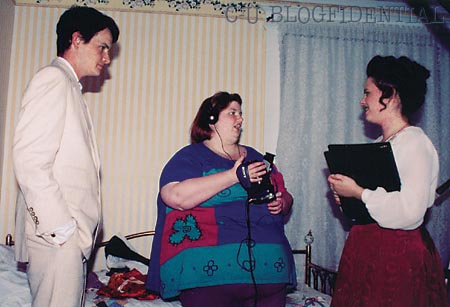
DESTINY is the first movie I made [myself]. I had never even picked up a camera before that. Filming as a hobby or a career had never occurred to me; I was a theater person, though, so I knew the basics of putting a show together. DESTINY was fully scripted [and] fully edited (albeit on the two-VCR premise) with music montages, period costumes, 17 locations, and 25 actors. It was 61 minutes long, and I was 17. Never let it be said that I live life in moderation.
I fell in love with making movies and made a second, DESTINY II, which was similar to the first in length and scale. The third movie I made, DESTINY III, was a much larger project and ended up running three hours and 12 minutes. I made movies until I was in college and then edited the DESTINY TRILOGY as a mini-series for Parkland Television [at Parkland College in Champaign]. Next was PANDORA’S BOX and it was originally supposed to be four episodes. It ended up [running for] 24. With episodic television, the story could go so much further, develop and change and grow [and since] what I love most of all is being able to tell a good story, I became addicted to making TV shows.
Now I’m working with Brian Paris on a short film (10-15 minutes) to focus my creative energy on quality more so than quantity – not to say that my other stuff wasn’t quality, of course, it just lacked a lot on the technical end.
JP: Will this be separate from the Yibbleverse?
ES: I’m hoping to co-brand it with the Sine Fine Films logo since it’s a joint project. However, it will be very different from most of my previous endeavors because it will be much shorter and actually have a crew, nice equipment, lighting, etc. In other words, it will have technical standards, not just, “Shoot the darn thing, I don’t care if it is dark and raining!”
JP: You mean dark and stormy nights weren’t a pre-planned running motif in your shows?
ES: It’s Illinois, Jason. It’s very rare that the weather cooperates for more than five minutes. Thunderstorms never pay attention to the shooting schedule anyway.
JP: True. Moving on … Will the new short be independently produced like all your other work? Also, how do you balance the demands of your own projects and the proverbial day job, which in your case happens to be as an editor for our local PBS television station and, therefore, in the same relative ballpark?
ES: Yes, the new short will be independently produced. As for how I balance the demands of my own projects with the demands of my oh-so-wonderful editing job at WILL-TV, that’s easy. Work comes first. After all, without work to provide a paycheck, there would be no money to make projects. And I find my work very rewarding. I have learned far more from working at WILL than I could learn on my own.
Primarily, I edit promotional spots, but I also get to produce and edit segments for the local show PRAIRIE FIRE. I find the latter particularly challenging and have learned an immense amount about location production, as well as new and innovative ways to tell a story. My favorite projects for PRAIRIE FIRE include segments about Cave-In-Rock State Park, George Rogers Clark, Fort Des Chartres in Prairie du Rocher, Illinois, and Vincennes, Indiana. Currently I’m working on a segment about Edgar Lee Masters and the Spoon River Valley that is promising to be quite excellent, if I do say so myself.
However, since I have a creative outlet at work, I don’t push to be constantly filming TV shows and movies on my own any more. Now I’m concentrating on quality over quantity in my independent work. Oh, and having lots of fun, of course.
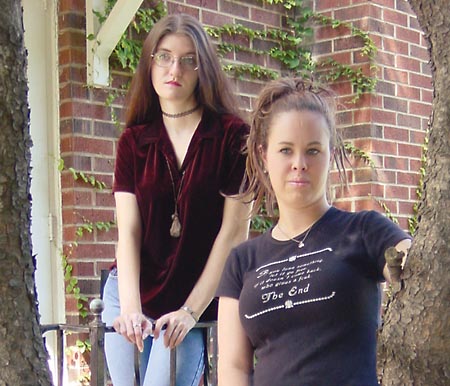
JP: It’s interesting that you single out the segment about a regional author. Have you ever considered adapting any of your father’s writings?
ES: Yes, I have, and his influence is everywhere in my work. However, most of his books would require a budget in order to make them as good as I would want to make them. I could adapt one of his short stories…
JP: … and there is one particular place where the implied budget of large proportions could be obtained for adapting your father’s science fiction stories properly if you make the right connections and deals – Hollywood. What became of the Big Move that you were considering a couple of years ago while making EIDOLON?
ES: The Big Move is still planned as an eventuality, but there is no set date. There are a number of reasons for this. Mostly, I don’t want to be one of those people who go flying out there with $10, big dreams, and no back-up plan, only to come crawling back home a year later completely broken. I have no doubt that I am an intelligent, talented, and creative writer/director/producer/editor who could excel in any one of those jobs. But, in many ways, I am not as much of a risk-taker as I would like to be. When I get into a comfort zone, it takes a lot to push myself out of it. And since I loathe “plastic” people, big cities, no changing seasons, and a seemingly endless amount of warm, sunny days, you can understand my reluctance to move there.
Seriously, dude, I could be a vampire if it wasn’t for the whole blood thing. I refer to my small, dark edit bay as my “bat cave,” and if I could take a nap by hanging upside down from the ceiling, I’d be set!
F I V E & O U T
Tell us, Miss Yibbleverse:
• What you’ve made:
10 movies, six TV shows, 22 segments for PRAIRIE FIRE, more than 100 DVDs and VHS tapes, several dozen costumes, 54 new friends, and a hole in my personal finances that you could drive a truck through.
DESTINY (1996)
Fantasy adventureDESTINY II (1996-7)
A prequel with an oh-so-original nameDESTINY III (1997)
The first two worked, so let’s try a third!FRUMPY GETS IT (1997)
Horrible murder mystery, enough said…THE DRAGON & THE UNICORN (1997-8)
Gothic tale about reincarnationTHE KING OF ELFLIN’S DAUGHTER (1998)
Celtic-based fairytaleTHE PERFECT COMBINATION (1998)
Modern romantic, slapstick comedyTHE VIGIL (1998)
Dramatic tale dealing with death and the afterlife, written by Joel PeirsonMIND GAMES (1998-9)
Psychological sci-fi about Death roaming a spaceship, written and co-directed by Edward StasheffDESTINY THE MINI-SERIES (1999)
Gosh, I loved the trilogy so much I did some extra filming, revamped it, and edited it all into a TV show – 12 half-hour episodesPANDORA’S BOX (1999-2000)
Post-apocalyptic dark ages in central Illinois – 24 half-hour episodesTHE CURSE (2001)
Ghosts and curses and archaeology, oh my! – 8 half-hour episodesTHE GIFT BEARER (2001-2)
Three sisters travel through time – 21 half-hour episodesDREAM CHASERS (2002)
I’m not really sure what this one’s about, other than it’s a dark and weird prequel to THE CURSE – 8 half-hour episodesEIDOLON (2003-5)
Sequel to THE CURSE … I just can’t get enough of them curses! – 13 half-hour episodesTHE CURSED DESTINY OF PANDORA’S GIFT BOX (2006)
A spoof of all my other movies and TV shows
• Which do you like best – film, video, or digital:
Digital video transferred onto film. Mostly, I just use video, though.
• Where is your geographical preference – Champaign, Urbana, the UIUC campus, or beyond city limits:
Wherever there’s a nice-looking location that pleads with me to film in it, usually beyond city limits. I’m highly partial to southern Illinois.
• What is the one movie project that you would like to do someday that nobody will ever see coming:
Ooh, that’s hard to say because I’ve worked in so many different genres over the years, including documentary, that I don’t think I could surprise anyone with anything I did. Except possibly to stop filming altogether … and actually follow through with it. No one would see that coming!
• Apart from your own movies, the one underappreciated gem that you think people should bend over backwards to check out is:
There are so many movies that are under-appreciated, but three of my favorites are LOVE ACTUALLY, EVER AFTER, and DUDLEY DO-RIGHT. Yes, you heard that right – DUDLEY DO-RIGHT.
LOVE ACTUALLY is one of the best movies that I have ever seen. It’s sweet, poignant, meaningful, and its overall message is portrayed beautifully through the (mostly) separate stories of several individuals. It’s the only movie that I have ever seen that attempts to make a single story out of several little stories that actually flowed into a true narrative.
EVER AFTER is a wonderful example of re-telling a fairy tale with modern ideas and influences without making the modern bits seem too out-of-place. And, it has Leonardo da Vinci and great costumes. What more could you ask for?
I have yet to meet anyone who agrees with me that DUDLEY DO-RIGHT is actually a good movie, but that’s because most people don’t understand the concept of melodrama. Yes, it’s over the top. It’s supposed to be over the top. If you like good, old-fashioned melodrama with all the standard characters, the nods to the audience that break the fourth wall, and general random silliness, then you will love DUDLEY DO-RIGHT.
Interview conducted September-November 2006 via e-mail.
All photos courtesy of Eleanore Stasheff/Sine Fine Films
except * taken by JaPan.
Web Source: Eleanore Stasheff [sinefinefilms@yahoo.com]
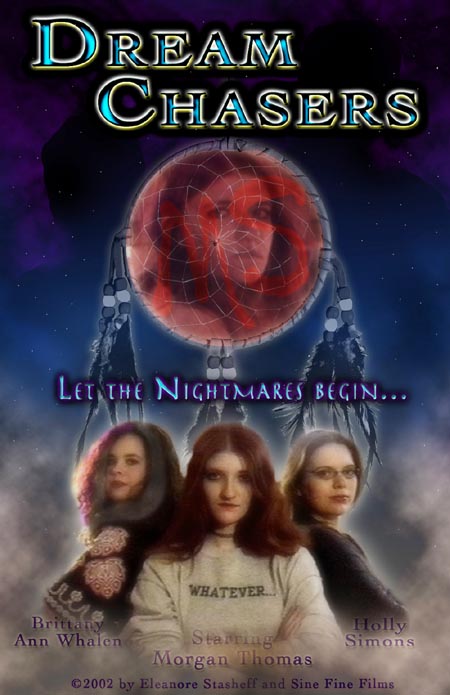
CUBlog Interview No.3 © 2007 Jason Pankoke